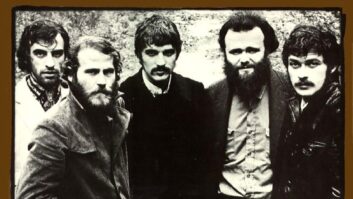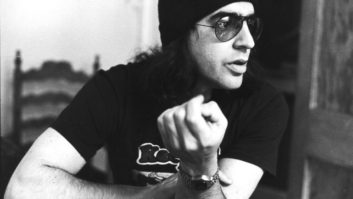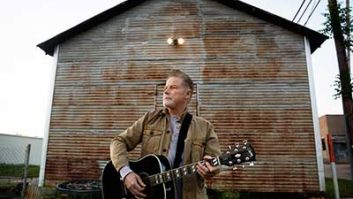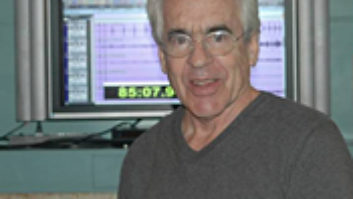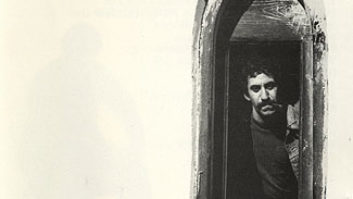Acclaimed by many as the greatest rock concert film ever made,
The Last Waltz — director Martin Scorsese’s riveting
depiction of the Thanksgiving 1976 farewell concert by The Band and a
gaggle of their musician friends — was a natural candidate to
make the jump to multichannel formats. Last fall and winter, the film
was completely restored and remixed. It enjoyed a brief run in selected
theaters this past spring, and was released by MGM Home Entertainment
on DVD in both 5.1 and conventional stereo. Additionally, Warner
Bros./Rhino came out with an expanded four-CD version of the popular
soundtrack.
As is usually the case with these sorts of
restoration/remastering projects, nothing was as simple as it seems.
But then, neither was the making of the original film, which, despite
its relatively straight documentary approach (with minimal additional
interview footage), sprawled over 18 months from the winter of ’77
through the spring of 1978.
“Everything was pretty much state-of-the-art for the
time,” remembers Steve Maslow, the veteran re-recording mixer who
mixed the music for the original film on the Goldwyn stage’s Quad 8
console. “They brought it in on [24-track], and initially they
wanted to do something that wasn’t done too much then — it might
have been one of the first movies to do it — which was to
interlock the multitracks to the film chain. It was quite cumbersome at
the time. I can’t even remember what they used — some sort of
film sync lock device — and it took at least 20 feet for the film
chain to lock up; it was pretty frustrating.
“It was quite time-consuming taking the [multitrack]
information and locking up the film channel and going to 3- or 4-track
mag. We EQ’d and made a little mix predubbed to 4-track mag, which
became the dubbing unit. We had almost two months of premixes, getting
everything from 16-track to the film, and then there was a little time
spent getting the production dialog from premix. Rob Fraboni, who was
the music producer, was involved almost from the beginning. Robbie
[Robertson, leader of The Band and producer of the film] showed up at
the final, mostly.
“The length of the mix was the longest I’d ever been
on,” Maslow continues. “It was six months, done mostly at
night. I had three days off: Thanksgiving, Christmas and New Year’s.
One reason the film as a whole took so long is [The Band] took the
tapes to their ranch and messed with them for a year, overdubbing bass
and keyboard and vocal parts. I remember one of the problems we had to
deal with was that Rick Danko had all-new bass tracks, and he
overdubbed them without regard to the sync fingering onscreen. So part
of what I had to do was every time he was on camera, I had to switch
from the overdub bass to the production bass and make it sound
seamless, which wasn’t easy because it had a slightly different quality
to it. As I recall, there were also quite a few piano overdubs, too,
but since you never saw Richard Manuel’s fingers, that wasn’t a
problem.”
Maslow, who had a background in conventional music mixing before
making the move into film, says that mixing The Last Waltz
“was incredibly challenging because there were a lot of really
interesting camera moves, and Scorsese wanted the sound to reflect the
movement onscreen. So, for instance, there might be a sequence where
the camera was moving, say, stage left to stage right with a sweep, and
we would actually pan the instrumentation and vocals with the camera
move. That was something I don’t think had been done before in a
concert film.
“Of course, in those days, we had no automation,” he
adds. “It was rather primitive compared to today. So there were a
few times when we had three, four, five people on the console handling
different instrumentation or vocals on the mix. It was quite a scene.
Very difficult to get that right, but also fun. The teamwork becomes
very important,” he says with a laugh. “Dolby had
just introduced surround, but we did what was essentially a 3-track
left-center-right stereo mix. There were no discrete surround tracks at
the time.”
Now flash forward 25 years and head out to nearby Santa Monica’s
Pacific Ocean Post (POP) Sound Studios, where Ted Hall remixed The
Last Waltz in surround for both its theatrical and 5.1 DVD release
under the supervision of Robbie Robertson. Hall, who was widely hailed
for his expert surround job on Yellow Submarine three years ago
(see Mix, September 1999), had his work cut out for him.
“What came to me were from the original 2-inch masters
transferred to Sony 3348 HR 24-bit,” he says. “And,
unfortunately, when they transferred the tapes, they ran the tapes
wild, so I had to resolve the tapes from the timecode on a digital
track, which was difficult. But once I got that up, there were issues
of music edits and sorting through the tapes and doing a lot of
archaeology to find out what was used. For instance, what vocals they
actually used, because they overdubbed them on some songs for the
[original Last Waltz] soundtrack album. Robbie’s mixer, Dan
Gellert [see “Remaking the Music,”, below] did stereo mixes
and made stems, splits — splitting out the guitars and
everything. He is the hero in this; his attention to detail is
outstanding. That was approved by Robbie soundwise and stereowise, and
then I made a 5.1 to match the original mix to some extent. That
original mix, which Scorcese worked on back in ’78, was a stereo mix
with lots of panning. So if the picture moved from the piano to the
guitar, the sound would move with it.
“Part of my job was not only to get everything in sync and
to get a nice-sounding 5.1 theatrical music mix happening, but to
re-create all these pans. I took the VHS release tape home for a couple
of days and mapped out as much as I could of what Steve Maslow had done
20 years ago; it was a humbling experience in this era of massive
automation and data networks. Some songs were pretty static, but almost
every one of them had some sort of dynamic panning going on. We mixed
everything digital on a Neve Logic 2 console with all panning, EQ,
dynamics, automated. I would go through the mix, get it to where I
thought it was working and then call up Robbie, and he’d drive over,
we’d run through a couple of songs and tweak. We’d listen in a
theatrical environment, and he was really good at picking out things
that involved the sound in a theatrical 5.1 environment. He’s a very
attentive, great guy. Everything he said was always totally
right-on.
“Eventually, before it was released, I made 5.1 stems and
took those to Andy Nelson at Fox, and we played it in a huge
room there just to give it its final little blessing and make sure that
everything translated well. It’s funny, I was working with old
¾-inch picture for the longest time. I didn’t actually see the new
picture until we went to Fox. And when I saw it there, I was
stunned.”
According to Hall, “Robbie’s whole intention with the 5.1
mix was to try to make you feel like you were there; he wanted it so
that after 90 minutes in the theater, you felt like you were at a
concert. The way we mixed it, it’s a little bit like you’re standing on
the stage and the band is around you. While most of the music is still
up front, there’s also music in the rears pretty much all the time;
there’s reverb, some drums and whatever the instrumentation is that
seems to wrap you into the mix, whether it’s a guitar or keyboard part.
There’s also very discrete crowd stuff going on [in the rears]. In
fact, there’s one guy who’s whistling all the time that drove me
absolutely nuts. The same whistle over and over again. Even Robbie was
saying, ‘Can’t you notch that guy out?’” Hall says
with a chuckle. He also notes that because Gellert “had mixed it
in more of a studio album style, for the 5.1, I tried to match the
ambience of the room [Winterland in San Francisco] using a couple of
processors to give it a little more of a live feel.
“Robbie was intent on really restoring this the right way,
so we took the time to do it right. I spent a lot of time getting the
original mix together and then probably another month mixing the music.
Dan would be working across town, and if there was anything I needed,
he’d send it to me and vice versa; we were swapping files. Getting the
movie just to where it should be before the 5.1 [work] took a while.
What Robbie wanted to do on the DVD was have a new 5.1 mix and the
original 2-track mix, mastered and EQ’d. That way, people at home can
listen to what it originally sounded like. And the people with surround
systems will definitely hear something exciting and new.”
THE WINTERLAND RECORDINGS Elliot Mazer’s Live
Elliot Mazer was the chief recording engineer for the live concert
that is central to The Last Waltz. In his words…
I had worked with The Band previously and had known them from
Woodstock and Albert Grossman’s office. I helped them with Music
From Big Pink, mostly around mastering time. They had mixed it, and
Robbie [Robertson] was concerned about how dull and dark it was. We
listened in my apartment and in the studio, A&R Studios, the old
Columbia studios on 7th Avenue. Turns out that it sounded dark and it
sounded great. They had not planned it that way, but the engineers that
worked on it were very conservative about EQ. A lot of it was done live
in the studio, and the 8-track multitrack tapes were worn. All of which
can make a project sound dull.
I also helped John Simon get the equipment and set up the studio for
their second album, The Band. It was recorded in a home in the
L.A. hills that had been built for Sammy Davis, Jr. And I had recorded
a live show with The Band at Wembley Stadium [London] in ‘74. So
I knew Robbie and The Band, and I was called in to record The Last
Waltz after Robbie and Rick heard Neil Young’s Time Fades
Away.
We met in L.A. at Shangri La, The Band’s studio in Malibu, and
talked about the show and traded ideas. Marty [Scorsese] had prepared a
shooting script that was based on the lyrics of each song. The camera
assignments and moves were built around the songs. We worked the setup
at Winterland, all the rehearsals at Winterland and the evening
rehearsals in the basement of the Miyako Hotel, which were magical.
The truck was one of Wally Heider’s trucks. Rob Fraboni mixed the
house sound at the gig. John Simon did many of the arrangements,
conducted various parts of the show and was very much involved with the
rehearsals. He had to teach the guest songs to The Band and worked with
the horns. John also played piano on a few songs in the show. Rob and
John also worked on the overdubs and mixes for the original LP.
The Heider crew was great. Ray Thompson, one of the greatest live
engineers, set up the piano sound and the house mics for the show. He
could not be there for the actual show, but he was very helpful.
I was responsible for the concert recording. Every aspect, every
detail of The Last Waltz was discussed and planned out to
perfection. We knew the entire show before it started. There was one
song in the show that had problems: Paul Butterfield walked out to the
wrong mic, Robbie broke a string and one of Marty’s lighting rigs went
down — all of this at the same time. By the time Robbie got new
strings and Butter was on the right mic, most of Marty’s cameras were
out of film. Marty told Robbie to go, and he covered the song with one
camera, I believe, until the crews had time to load new magazines on
the other six cameras.
The tape format was 2-inch, 24-track on 3M machines with Dolby A
noise reduction. We had two machines running on overlap, and I think we
got every song on both machines. But at some points, the power dipped
so low that on a few tracks we had hum since the Dolby units were not
connected to the same power source as the machines and console.
The vocal mics were Beyer ribbon models. The Band had great mic
technique, and these mics had good off-axis response, which allowed for
a lot of jumping around — the singers didn’t have to eat the
mics. We had mics from my studio, His Masters Wheels, the Heider’s mics
and the P.A. mics. We even painted the mic stands black so that they
did not glare on film — Keith Monks stands and booms! So as not
to screw with Marty’s shots, we put up no drum overheads and put mics
under the cymbals facing up instead. Levon’s vocal mic gave us an extra
amount of air on the drums.
We used every input on the API Heider board, and I believe that I
used my Neve BCM 10/2 for additional inputs. We mixed the drums to four
tracks and everything else was isolated. No compressors, no gates and
generous EQ.
REMAKING THE MUSIC
As independent engineer Dan Gellert tells the story, he first met
Robbie Robertson when The Last Waltz project was in the planning
stages. Robertson needed an engineer to remix the entire original album
for both an expanded CD re-release and the remastered film soundtrack.
Also planned was a DVD-Audio release (in 5.1 surround), which, like the
four-CD boxed set, would include a slew of previously unreleased
performances. “It was a long process to do, for sure,”
recalls Gellert, who eventually spent about 125 days working on the
various remixes.
Originally from New York, Gellert started his career at the Power
Station (now Avatar), eventually reaching the position of chief
engineer. After developing a roster of clients while at Avatar, Gellert
went independent about two-and-a-half years ago. Recent projects have
included remixing tracks for two Robbie Robertson projects, mixing an
album for Sweet Honey in the Rock and recording jazz pianist Akiko
Grace with her trio.
Gellert joined The Last Waltz project after the original
tapes — including five hours’ worth of 24-track multitracks from
the concert, plus the “Last Waltz Suite” and other tapes
recorded on a Hollywood soundstage after the event — had been
transferred to 48-track digital format. “The signal chain was as
clean as possible, just straight into the Sony 3348, which is
24-bit,” explains Gellert. “Unfortunately, I was brought
into the project just as the transfers were done. [I say] unfortunately
because the transfers weren’t done perfectly — not the audio,
which was fine, but the clocking, which was a problem. We had to figure
out how to fix that in the end when the music got synched to
film.”
Gellert’s first task was to listen to all of the tapes to find the
correct performances to mix for the film soundtrack. “There were
a lot of extras — a lot of tapes, a lot of outtakes — so I
had to weed through it all to see what would make sense,” he
says. Not surprisingly, documentation was less than comprehensive.
“With anything from that long ago, the first thing to go away is
the documentation, the track sheets. We had 50 or 60 large reels of
48-track digital multitracks, so I started by going through them to
find the extra bits, and some bits that no one has heard. So that was a
long process in and of itself, just listening.” Not only were
there duplicate tapes to sort out, with no documentation to show which
was the master, but occasional musical patches, overdubbed on the
master tapes after the concert, had to be identified and logged.
“It went in stages,” recalls Gellert. “The first
stage was the transfers, and then I got all the tapes. Then the next
stage was listening to everything before I started delving into mixing
it. Finding out what was going to be useful and then creating a
schedule for mixing it all. We decided to mix the original album first,
then the extra stuff and then what was in the film that wasn’t on the
album.
“My original plan was to mix each song in stereo and then go
to the surround version. But after the first one or two songs, I
realized this was not the most efficient way to do it,” he
continues. “I found that for this kind of project, mixing in
surround is such a different beast. The subwoofer excites the room in
such a different way that to go between the two formats quickly wasn’t
efficient — you had to get your head around the room sounding
very different. So, I mixed it all to stereo first; all of the original
album, things in the movie that were not on the original album, the
extra stuff I found, like the jams and rehearsals and ‘The Last
Waltz Suite,’ everything. Then I went back and concentrated on
the surround mixes.”
All the mixes were done on an SSL Axiom MT digital console, with
stereo mixes committed to an Ampex ATR-102 running ½-inch analog
tape. “We mixed to other formats, but that’s what ended up
winning for the stereo,” comments Gellert. Surround mixes were
captured in 24-bit Pro Tools sessions. All stereo mixes were monitored
on Yamaha NS-10s, while Gellert set up Genelec 1031s and a matching
subwoofer for the 5.1 surround mix.
The private studio was well-equipped with a combination of classic
analog devices and the latest digital processors. “One of the
great devices that I really enjoyed using was the Sony S-777 sampling
reverb,” he says. “It just sounds accurate, like you’re
actually in the space. I used that a lot, and a Lexicon 960.”
How did Gellert approach the remixes of an album that many consider
a classic? “I started out listening to the original. I wanted
this version to bring out all of the musical detail that was masked in
the original, and also to have a real impact. That was my
agenda.” To achieve consistency with the rhythm and vocal levels,
Gellert used some compression but more often relied on fader rides,
which were captured and repeated by the MT’s automation system.
“Compressors would level it out a little bit, but to make it
really level out was just eating up too much,” he explains.
As it turned out, Gellert had to do quite a bit of preliminary work
before actually getting down to mix each track. “Every song was a
little bit different,” he says. “There were so many
different performers, and people would move around the stage. I mixed
54 songs altogether, and after mixing the 20th song, you’d think I
could say, ‘Okay, I know what’s coming.’ But there was
always some technical thing I had to spend time with. On ‘The
Last Waltz Suite,’ I had to find the right performances by
A/B’ing with the record to make sure it was the right take. It wasn’t
straightforward, but that was the process and was expected by
everybody.”
Not surprisingly, Gellert had to make adjustments for different
players on the same instruments. For example, Richard Manuel’s grand
piano sounded very different when Dr. John sat down for the New Orleans
funk of “Such a Night.”
“I found that when Levon [Helm] was singing and playing, the
drums sounded very different from when someone else was singing,”
adds Gellert. “It’s a natural physical thing — when he’s
singing, he plays differently. The horns were also a little difficult
to bring out.”
Gellert and Robertson quickly established a routine. “I’d mix
all day, and he would come in toward the end of the day and we’d listen
and tweak the mix, maybe an hour, maybe two, and then it was
done,” explains Gellert. “It was the optimal way to do it.
I got it sounding the way he wanted to hear it — I learned that
pretty quickly — and then he’d make little fixes here and there,
just updating the mixes.”
For the stereo mix, Gellert and Robertson opted for a wide stereo
soundscape. “For the live concert, the premise was to make you
feel like you’re a little too close to the stage, in the first row, so
the stage is really wide, with the piano way to the left, Robbie’s
guitar way to the right,” explains Gellert. “That was the
idea: To make it really wide and to have the ambience of the arena come
from behind. I was very happy with it. With ‘The Last Waltz
Suite,’ I made it as wide as possible and I played more with all
of the available stereo fields, not just the left/right front but, for
example, the left front and right rear, as well. I mixed the extra
tracks after I mixed the rest of the stuff, so I had an idea of what I
wanted it to sound like. It was fun hearing tracks that, unless you’d
been at the concert, you wouldn’t have heard before.”
The surround mixes for the DVD-Audio release were addressed on a
case-by-case basis. “Some were similar, some were quite
different,” says Gellert. “On some of them, I did a
surround mix for the DVD movie and the film and then tweaked it a
little bit differently for the DVD-Audio. It needed to be a bit
different, because you’re not looking at the movie.”
Once Gellert completed the mixes for the film and video releases,
they went over to Ted Hall at Pacific Ocean Post. “I was there
listening to stuff; both Robbie and I went there now and then,”
says Gellert, “but Ted did such a fantastic job. He had all the
elements — the original dialog and all that — and he had
the same nightmare I had of finding the right things and making sure
that it’s appropriate and correct and the best it can be at this
point.”
